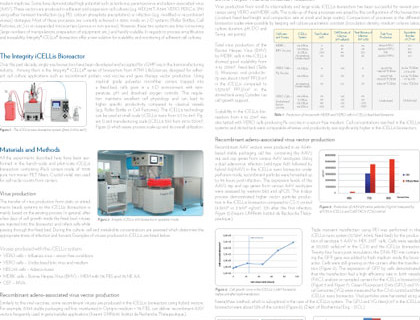
Innovative Products and Great Posters Featured at the Bioprocess International Conference – Part II
Last week, I posted a blog on innovative products that caught my eye at the Bioprocess International Conference in Boston. For readers who could not attend the conference or missed wandering the exhibit and poster hall, I included a brief description of some of the products featured this year. Below is Part II of my summary where I have highlighted some great posters from the conference and have included links to the posters. I am hoping to follow up these brief descriptions with guest blogs to describe some of the products in more detail in the coming months.
ATMI’s iCELLis Fixed-Bed Bioreactor
ATMI presented an interesting poster on its iCELLis system titled “Viral Vector Production in the Integrity iCELLis Single-Use Fixed-Bed Bioreactor, From Bench Scale to Industrial Scale.” The poster outlines experiments conducted to demonstrate the use of iCELLis in adherent cultures for the production of recombinant proteins, viral vaccine and Gene Therapy vectors. The iCELLis system utilizes microfiber carriers trapped in a fixed-bed, which allows for 3-D growth with temperature, pH, and dissolved oxygen controls and offers an alternative to 2-D systems like roller bottles.
Key advantages presented include:
· Facilitates handling and scale-up
· High biomass amplification
· Sterile containment within a closed system
· Can enhance viral production yields
Repligen’s Long R3IGF-1
Repligen presented a very informative poster, titled “Recombinant Long R3 IGF-1 and rTransferrin Improved Growth and Production of Two Suspension Chinese Hamster Ovary Cell Lines.” One of the interesting things about this poster is that it looked at the effectiveness of Long R3 IGF-1 when added to commercially relevant media, rather than just looking at adding it to DMEM. The study examines the effects of Long R3 IGF-1 on two antibody expressing CHO cell lines when compared to rInsulin and no growth factor supplemented media. What they found is that media supplemented with Long R3 IGF-1 provided superior titers in many instances when compared to rInsulin and no growth factor supplemented media. Another interesting finding was that the combination of Long R3 IGF-1 and rTransferrin outperformed commercial ITS (rInsulin, rTransferrin, and selenium) in several commercial media.
Due to the low concentration needed for efficacy, Long R3 IGF-1 provides an effective tool for optimizing protein-free media or replacing rInsulin. Repligen also presented a poster titled, “Development and Characterization of a Long R3 IGF-1 ELIZA.” This poster describes how an ELIZA was developed to quantitate Long R3 IGF-1 for use in upstream to optimize concentration and feeding strategies and for use downstream in purification and clearance.
Poster conclusions include:
· Long R3 IGF-1 is more effective than rInsulin in increasing protein synthesis from CHO cell lines when supplemented to growth factor free media
· Long R3 IGF-1 and rTransferrin is more potent than ITS solution in increasing productivity of CHO cell lines
· Long R3 IGF-1 yielded higher or comparable titer to rInsulin when used at 1,000 fold lower concentration
Irvine Scientific’s BalanCD CHO Growth A
Irvine Scientific’s media, BalanCD CHO Growth A is a chemically defined media that was designed as a high-performance CHO production medium. In this study, Irvine Scientific examines whether it can also address the challenges of switching media throughout various cell line development activities by providing an effective single media solution for the entire production process. Their poster, “A Single Chemically-Defined Culture Medium Supporting a Wide-Range of Development Activities for the Production of Biologics,” demonstrates how they were able to use this single media for cell line development and then scale up to large-scale production. They tested the medium for cloning applications using both automated single-cell cloning (ClonePix) and traditional single cell cloning (limiting dilution assay) methods. They were able to show that the medium was effective as a cloning medium and was scalable from 96-well plates to 2,000L scale. Thus, providing a seamless transition for the production process.
Corning’s HYPERStack Cell Culture Vessel
Corning presented an informative poster on the use of their HYPERStack system titled “Using the Corning HYPERStack Cell Culture Vessel and the Enhanced Attachment Microcarriers for Scale-Up and Production in the Vaccine Industry.” The study presented looked at both the efficacy of generating adeno- and lentiviral particles using the HYPER technology and the use of Enhancement Attached microcarrier beads for cell expansion of vaccine producing cell lines – vero and HEK293.
Key findings from the study include:
· Lentiviral and adenoviral particles can be generated in HYPERStack Vessels at similar titers to normal tissue culture vessels
· HYPERStack allows for greater virus production in a smaller footprint when compared with traditional systems
· Generated particles exhibited similar levels of infectivity
· Microcarrier beads can be successfully used to expand vero and HEK293AD cells
· Preliminary studies show that Enhanced Attachment Microcarriers can be used in adenovirus production.